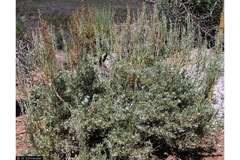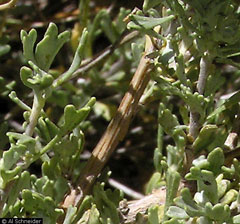 |
|
Al Schneider @ USDA-NRCS PLANTS Database |
 |
| Al Schneider @ USDA-NRCS PLANTS Database |
Translate this page:
Summary
Physical Characteristics

 Artemisia nova is an evergreen Shrub growing to 0.5 m (1ft 8in). It is in leaf all year. The species is hermaphrodite (has both male and female organs) and is pollinated by Wind.
Artemisia nova is an evergreen Shrub growing to 0.5 m (1ft 8in). It is in leaf all year. The species is hermaphrodite (has both male and female organs) and is pollinated by Wind.
Suitable for: light (sandy) and medium (loamy) soils and prefers well-drained soil. Suitable pH: neutral and basic (mildly alkaline) soils and can grow in very alkaline soils.
It can grow in semi-shade (light woodland) or no shade. It prefers dry or moist soil and can tolerate drought.
UK Hardiness Map
US Hardiness Map
Synonyms
A. arbuscula. Nutt.
Plant Habitats
Cultivated Beds;
Edible Uses
References More on Edible Uses
Medicinal Uses
Plants For A Future can not take any responsibility for any adverse effects from the use of plants. Always seek advice from a professional before using a plant medicinally.
Miscellany
A decoction of the leaves is used in the treatment of coughs, colds and headaches[61, 257].
References More on Medicinal Uses
The Bookshop: Edible Plant Books
Our Latest books on Perennial Plants For Food Forests and Permaculture Gardens in paperback or digital formats.

Edible Tropical Plants
Food Forest Plants for Hotter Conditions: 250+ Plants For Tropical Food Forests & Permaculture Gardens.
More

Edible Temperate Plants
Plants for Your Food Forest: 500 Plants for Temperate Food Forests & Permaculture Gardens.
More

More Books
PFAF have eight books available in paperback and digital formats. Browse the shop for more information.
Shop Now
Other Uses
References More on Other Uses
Cultivation details
Easily grown in a well-drained circumneutral or slightly alkaline loamy soil, preferring a sunny position. This species has some affinity for calcareous soils[164]. Established plants are very drought tolerant[200]. Plants are longer lived, more hardy and more aromatic when they are grown in a poor dry soil[245]. Unlike several closely related species, this plant does not layer or sprout from the stump if it is cut back[164]. Plants in this genus are notably resistant to honey fungus[200]. Members of this genus are rarely if ever troubled by browsing deer[233].
References Carbon Farming Information and Carbon Sequestration Information
Temperature Converter
Type a value in the Celsius field to convert the value to Fahrenheit:
Fahrenheit:
The PFAF Bookshop
Plants For A Future have a number of books available in paperback and digital form. Book titles include Edible Plants, Edible Perennials, Edible Trees,Edible Shrubs, Woodland Gardening, and Temperate Food Forest Plants. Our new book is Food Forest Plants For Hotter Conditions (Tropical and Sub-Tropical).
Shop Now
Plant Propagation
Seed - surface sow from late winter to early summer in a greenhouse in a very free-draining soil, but make sure that the soil does not dry out. Germination usually takes place in 1 - 2 weeks in a warm greenhouse[164]. When large enough to handle, prick the seedlings out into individual pots and grow them on in the greenhouse for their first winter, planting them out in late spring or early summer. Cuttings of half-ripe wood, July/August in a frame. Division in spring or autumn.
Other Names
If available other names are mentioned here
Native Range
NORTHERN AMERICA: United States (Colorado (west), Idaho, Montana (west), Wyoming, New Mexico (west), Arizona, California, Nevada, Utah)
Weed Potential
Right plant wrong place. We are currently updating this section.
Please note that a plant may be invasive in one area but may not in your area so it's worth checking.
Conservation Status
IUCN Red List of Threatened Plants Status :

| Related Plants
|
| Latin Name | Common Name | Habit | Height | Hardiness | Growth | Soil | Shade | Moisture | Edible | Medicinal | Other |
| Artemisia abrotanum | Southernwood | Shrub | 1.2 |
4-8
| | LMH | SN | DM | 1 | 3 | 3 |
| Artemisia absinthium | Wormwood, Absinthium. | Perennial | 1.0 |
4-9
| M | LM | SN | DM | 1 | 3 | 3 |
| Artemisia annua | Qing Hao, Sweet sagewort | Annual | 3.0 |
6-9
| F | LM | SN | DM | 1 | 4 | 2 |
| Artemisia anomala | | Perennial | 1.0 |
-
| | LMH | SN | M | 0 | 2 | |
| Artemisia arborescens | Tree Wormwood | Shrub | 1.0 |
8-10
| F | LM | N | DM | 0 | 2 | 3 |
| Artemisia argyi | | Perennial | 1.5 |
-
| | LM | SN | DM | 0 | 2 | |
| Artemisia biennis | Biennial Wormwood | Annual/Biennial | 1.0 |
3-8
| | LM | SN | DM | 1 | 1 | 1 |
| Artemisia californica | California Sagebrush | Shrub | 2.0 |
7-10
| F | LM | N | DM | 0 | 2 | 3 |
| Artemisia campestris | Field Southernwood | Perennial | 1.5 |
3-8
| | LM | SN | DM | 1 | 2 | 1 |
| Artemisia campestris glutinosa | | Perennial | 1.5 |
-
| | LM | SN | DM | 0 | 0 | 1 |
| Artemisia capillaris | Yin Chen Hao | Shrub | 0.5 |
6-9
| | LM | SN | DM | 1 | 3 | |
| Artemisia carruthii | Carruth Wormwood | Perennial | 0.4 |
4-9
| M | LM | N | DM | 1 | 0 | 0 |
| Artemisia caruifolia | | Annual | 1.0 |
-
| | LM | SN | DM | 1 | 3 | 1 |
| Artemisia cina | Cina, Santonica | Shrub | 1.0 |
0-0
| | LM | S | DM | 0 | 3 | |
| Artemisia dracunculoides | Russian Tarragon, Tarragon, French Tarragon | Perennial | 1.0 |
5-8
| M | LM | SN | DM | 2 | 1 | 3 |
| Artemisia dracunculus | Tarragon, French Tarragon | Perennial | 0.6 |
5-9
| M | LM | SN | DM | 4 | 2 | 3 |
| Artemisia filifolia | Sand Sage, Sand sagebrush | Shrub | 1.2 |
3-7
| | LM | SN | DM | 0 | 2 | 1 |
| Artemisia frigida | Fringed Wormwood, Prairie sagewort | Perennial | 0.3 |
3-8
| | LM | N | DM | 2 | 2 | 3 |
| Artemisia glacialis | Glacier Wormwood | Perennial | 0.2 |
4-8
| | LMH | N | DM | 1 | 2 | |
| Artemisia gmelinii | Russian Wormwood, Gmelin's wormwood | Perennial | 1.5 |
3-7
| | LMH | N | DM | 1 | 1 | 2 |
| Artemisia herba-alba | White Wormwood | Shrub | 0.3 |
7-10
| F | LM | N | DM | 0 | 3 | 3 |
| Artemisia indica | | Annual/Perennial | 1.2 |
6-9
| | LM | SN | DM | 1 | 3 | 2 |
| Artemisia japonica | | Perennial | 1.0 |
7-10
| | LMH | SN | DM | 1 | 2 | 1 |
| Artemisia keiskeana | | Perennial | 0.6 |
-
| | LMH | SN | DM | 2 | 1 | 2 |
| Artemisia laciniata | Siberian wormwood | Perennial | 0.0 |
0-0
| | LMH | SN | DM | 1 | 0 | |
| Artemisia lactiflora | White Mugwort | Perennial | 1.5 |
4-8
| S | LMH | SN | M | 0 | 2 | |
| Artemisia lancea | | Perennial | 1.2 |
-
| | LMH | SN | DM | 1 | 1 | |
| Artemisia ludoviciana | White Sage, Louisiana Sage, Prairie Sage, Western Mugwort | Perennial | 1.0 |
3-9
| M | LM | SN | DM | 2 | 2 | 2 |
| Artemisia ludoviciana gnaphalodes | White Sage | Perennial | 1.0 |
4-8
| | LM | SN | DM | 0 | 2 | 1 |
| Artemisia maritima | Sea Wormwood | Shrub | 0.6 |
6-9
| | LM | N | DM | 1 | 2 | 1 |
|
|
Growth: S = slow M = medium F = fast. Soil: L = light (sandy) M = medium H = heavy (clay). pH: A = acid N = neutral B = basic (alkaline). Shade: F = full shade S = semi-shade N = no shade. Moisture: D = dry M = Moist We = wet Wa = water.
Now available:
Food Forest Plants for Mediterranean Conditions
350+ Perennial Plants For Mediterranean and Drier Food Forests and Permaculture Gardens.
[Paperback and eBook]
This is the third in Plants For A Future's series of plant guides for food forests tailored to
specific climate zones. Following volumes on temperate and tropical ecosystems, this book focuses
on species suited to Mediterranean conditions—regions with hot, dry summers and cool, wet winters,
often facing the added challenge of climate change.
Read More
Expert comment
Author
A.Nels.
Botanical References
60
Links / References
For a list of references used on this page please go here
Readers comment
| Add a comment |
|
If you have important information about this plant that may help other users please add a comment or link below. Only comments or links that are felt to be directly relevant to a plant will be included. If you think a comment/link or information contained on this page is inaccurate or misleading we would welcome your feedback at [email protected]. If you have questions about a plant please use the Forum on this website as we do not have the resources to answer questions ourselves.
* Please note: the comments by website users are not necessarily those held by PFAF and may give misleading or inaccurate information.
To leave a comment please Register or login here All comments need to be approved so will not appear immediately.
|
|